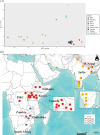The genomics of t'ef and finger millet domestication and spread
- PMID: 40370026
- PMCID: PMC12079134
- DOI: 10.1098/rstb.2024.0196
The genomics of t'ef and finger millet domestication and spread
Abstract
The Northern Highlands of Ethiopia and Eritrea (NHE) were a centre for food production in Africa, hosting one of the earliest agriculture-based complex societies on the continent. The NHE's geographical connections with the Arabian Peninsula, and Nilotic cultures led to the cultivation of southwest Asian crops and African native domesticates in its territory. Additionally, the NHE were also the domestication centre for crops like t'ef (Eragrostis tef (Zucc.) Trotter) and finger millet (Eleusine coracana L. Gaertn L.), after well-adapted local wild plants. Considering the paucity of the archaeobotanical record in the region and food remains' preservation issues, in this study, we aim to investigate the domestication and spread of t'ef and finger millet using genomics and interpreting the results in the light of archaeological proxies. Our data confirmed Eragrostis pilosa and Eleusine coracana subsp. africana as the sole wild progenitors of t'ef and finger millet, respectively. T'ef was initially domesticated in the NHE before spreading into southern Ethiopia and eastwards into southern Arabia. Finger millet spread followed two routes: one leading eastwards through the Red Sea to India, and the other southwards, through Kenya and Uganda, reaching southern Africa.This article is part of the theme issue 'Unravelling domestication: multi-disciplinary perspectives on human and non-human relationships in the past, present and future'.
Keywords: DArTSeq; Ethiopia; archaeobotany; diversity; origins of agriculture.
Conflict of interest statement
We declare we have no competing interests.
Figures





Similar articles
-
On the verge of domestication: Early use of C4 plants in the Horn of Africa.Proc Natl Acad Sci U S A. 2023 Jul 4;120(27):e2300166120. doi: 10.1073/pnas.2300166120. Epub 2023 Jun 26. Proc Natl Acad Sci U S A. 2023. PMID: 37364120 Free PMC article.
-
Comparative Metagenomic Analysis of Seed Endobiome of Domesticated and Wild Finger Millet Species (Eleusine spp.): Unveiling Microbial Diversity and Composition.Curr Microbiol. 2024 Sep 23;81(11):373. doi: 10.1007/s00284-024-03891-7. Curr Microbiol. 2024. PMID: 39313592
-
Commensal domestication pathways amongst plants: exploring segetal and ruderal crop origins.Philos Trans R Soc Lond B Biol Sci. 2025 May;380(1926):20240190. doi: 10.1098/rstb.2024.0190. Epub 2025 May 15. Philos Trans R Soc Lond B Biol Sci. 2025. PMID: 40370025 Free PMC article.
-
The sleeping crops of eastern North America: a new synthesis.Philos Trans R Soc Lond B Biol Sci. 2025 May;380(1926):20240192. doi: 10.1098/rstb.2024.0192. Epub 2025 May 15. Philos Trans R Soc Lond B Biol Sci. 2025. PMID: 40370024 Free PMC article. Review.
-
Phenomics and genomics of finger millet: current status and future prospects.Planta. 2019 Sep;250(3):731-751. doi: 10.1007/s00425-019-03159-6. Epub 2019 Apr 9. Planta. 2019. PMID: 30968267 Review.
Cited by
-
Unravelling domestication: introduction to the theme issue.Philos Trans R Soc Lond B Biol Sci. 2025 May;380(1926):20240187. doi: 10.1098/rstb.2024.0187. Epub 2025 May 15. Philos Trans R Soc Lond B Biol Sci. 2025. PMID: 40370018 Free PMC article. No abstract available.
References
-
- Childe VG. 1952. New light on the most ancient east., 4th edn. London, UK: Routledge & K. Paul.
-
- Smith BD. 2001. The transition to food production. In Archaeology at the millennium: a sourcebook (eds Feinman GM, Price TD), pp. 199–229. New York, NY, USA: Kluwer Academic/Plenum Publishers.
-
- Barbier EB. 2010. Scarcity and frontiers: how economies have developed through natural resource exploitation. Cambridge, UK: Cambridge University Press.
-
- Herrera RJ, Garcia-Bertrand R. 2018. The agricultural revolutions, pp. 475–509. Amsterdam, The Netherlands: Elsevier Science & Technology.
MeSH terms
Grants and funding
LinkOut - more resources
Full Text Sources
Miscellaneous

